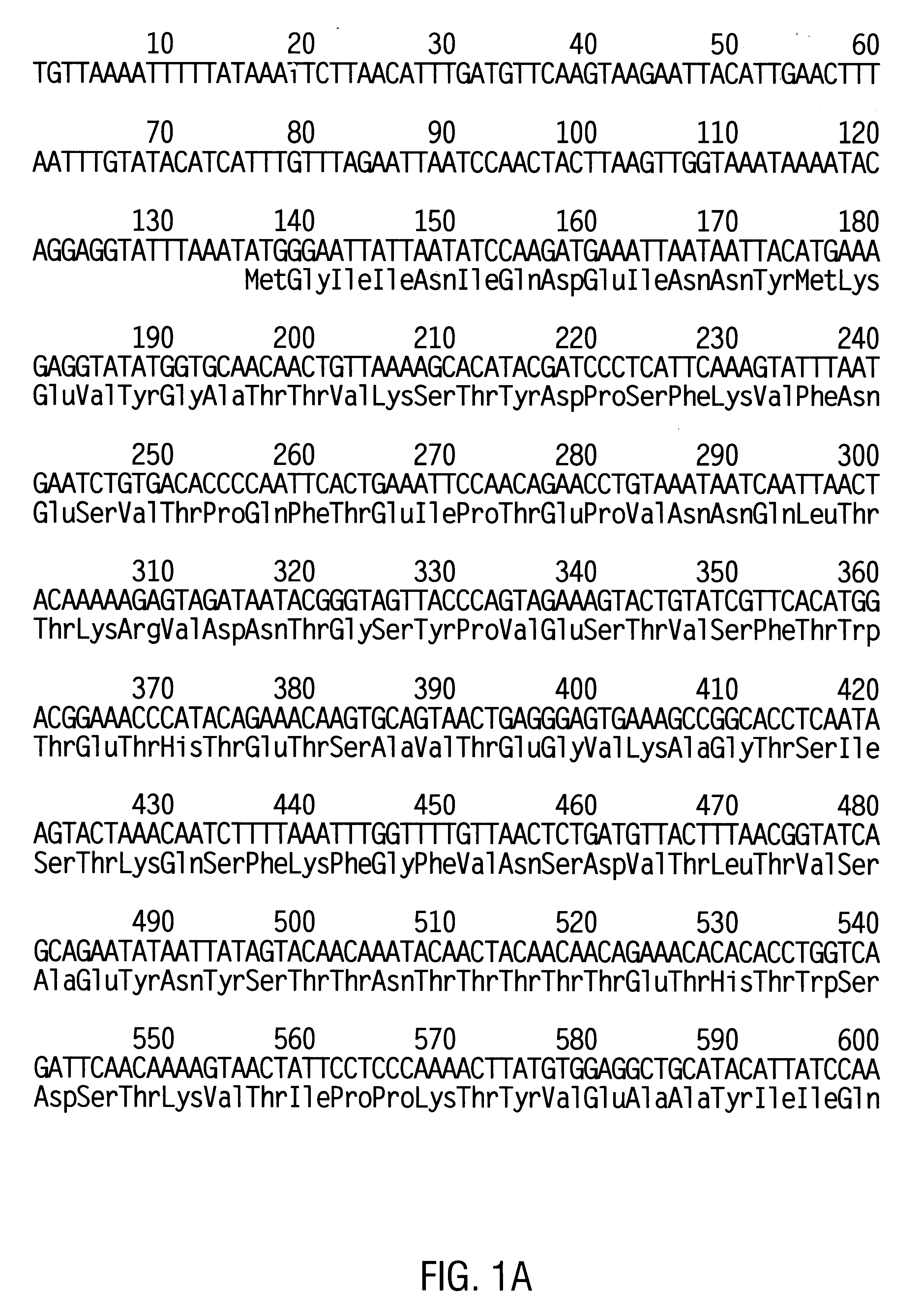Bacillus thuringiensis CryET33 and CryET34 compositions and uses therefor
a technology of cryet and bacillus thuringiensis, which is applied in the field of molecular biology, can solve the problems of insect death, insect feeding stoppage, insect toxic cryet proteins, etc., and achieve the effect of being readily available for commercial us
- Summary
- Abstract
- Description
- Claims
- Application Information
AI Technical Summary
Benefits of technology
Problems solved by technology
Method used
Image
Examples
example 1
5.1 Example 1
Isolation of B. thuringiensis EG10327
Crop dust samples were obtained from various sources throughout the U.S. and abroad, typically grain storage facilities. The crop dust samples were treated and spread on agar plates to isolate individual Bacillus-type colonies as described in U.S. Pat. No. 5,264,364.
The cloned cryIIIA gene, formerly known as the cryC gene of B. thuringiensis strain EG2158, described in Donovan et al., (1988), and the cloned cryIIIB2 gene, formerly known as the cryIIIC gene of B. thuringiensis strain EG4961, described in Donovan et al., 1992, were used as probes in colony hybridization procedures. The cryIIIA gene probe consisted of a radioactively labeled 2.0 kb HindIII-XbaI DNA restriction fragment as described in Donovan et al., 1988. The cryIIIB2 gene probe consisted of a radioactively labeled 2.4 kb SspI DNA restriction fragment as described in Donovan et al., 1992. The colony hybridization procedures were performed as described in U.S. Pat. No. ...
example 2
5.2 Example 2
Evaluation of the Flagellar Serotype of EG10327
To characterize strain EG10327 several studies were conducted. One study was performed to characterize its flagellar serotype. These data are provided below.
The flagellar serotype of strain EG10327 was determined in the laboratory of Dr. M. -M. Lecadet at the Pasteur Institute, Paris, France. The serotype of EG10327 was determined according to methods described by H. de Barjac (1981), and was found to be Bacillus thuringiensis kurstaki (H3a, 3b, 3c). Previously described B. thuringiensis strains containing cryIII-related genes were found to be serotype morrisoni (strain EG2158 containing cryIIIA); serotype tolworthi (strain EG2838 containing cryIIIB); and serotype kumamoloensis (strain EG4961 containing cryIIIB2) (Rupar et al., 1991). EG10327 represents the first B. thuringiensis kurstaki strain that has been shown to be toxic to coleopterans.
example 3
5.3 Example 3
Evaluation of the Crystal Proteins of EG10327
Strain EG10327 was further evaluated by characterizing the crystal proteins it produces. These studies were performed by growing EG10327 in DSG sporulation medium [0.8% (wt. / vol.) Difco nutrient broth, 0.5% (wt. / vol.) glucose, 10 mM K.sub.2 HPO.sub.4, 10 mM KH.sub.2 PO.sub.4, 1 mM Ca(NO.sub.3).sub.2, 0.5 mM MgSO.sub.4, 10 .mu.M MnCl.sub.2, 10 .mu.M FeSO.sub.4 ]. The sporulated culture containing both spores and crystal proteins was then harvested by centrifugation and suspended in deionized water. Crystal proteins were solubilized from the suspension of EG10327 spores and crystals by incubating the suspension in solubilization buffer [0.14 M Tris pH 8.0, 2% (wt. / vol.) sodium dodecyl sulfate (SDS), 5% (vol. / vol.) 2-mercaptoethanol, 10% (vol. / vol.) glycerol and 0.1% (wt. / vol.) bromophenol blue] at 100.degree. C. for 5 min.
The solubilized crystal proteins were size fractionated by electrophoresis through an acrylamide gel (SDS-P...
PUM
| Property | Measurement | Unit |
|---|---|---|
| temperatures | aaaaa | aaaaa |
| temperatures | aaaaa | aaaaa |
| temperatures | aaaaa | aaaaa |
Abstract
Description
Claims
Application Information
 Login to View More
Login to View More - R&D
- Intellectual Property
- Life Sciences
- Materials
- Tech Scout
- Unparalleled Data Quality
- Higher Quality Content
- 60% Fewer Hallucinations
Browse by: Latest US Patents, China's latest patents, Technical Efficacy Thesaurus, Application Domain, Technology Topic, Popular Technical Reports.
© 2025 PatSnap. All rights reserved.Legal|Privacy policy|Modern Slavery Act Transparency Statement|Sitemap|About US| Contact US: help@patsnap.com



